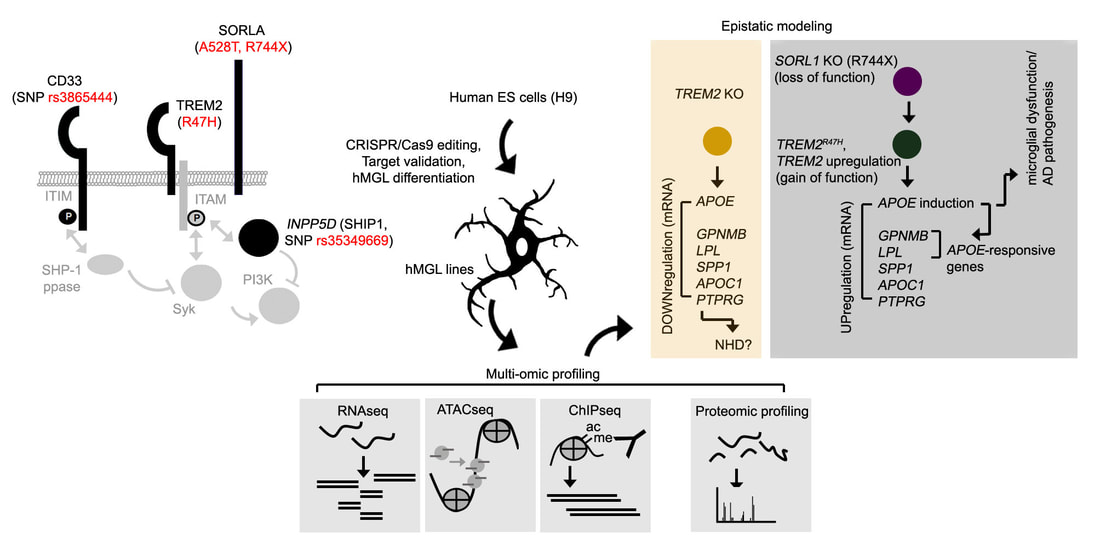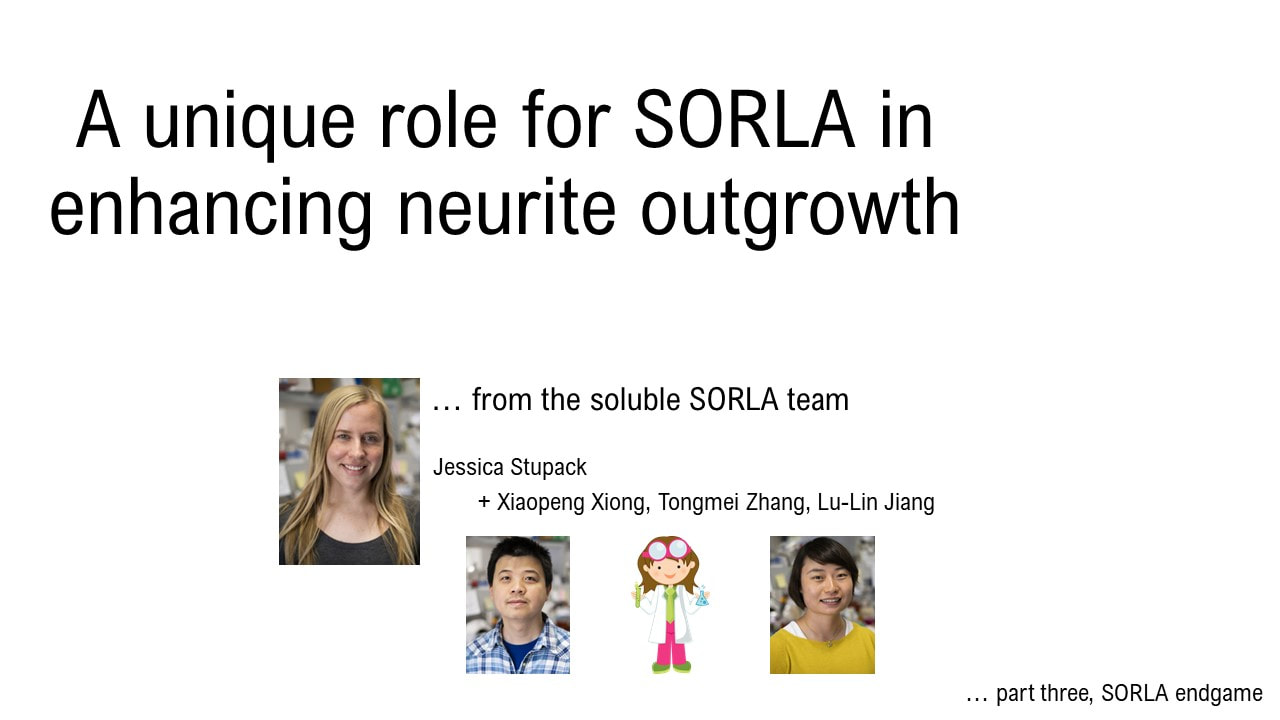About us
We are a research team dedicated to Alzheimer's disease (AD) and neurodegeneration research at
Sanford Burnham Prebys Medical Discovery Institute (SBP), La Jolla (California)
Welcome... old friends and new!
Sanford Burnham Prebys Medical Discovery Institute (SBP), La Jolla (California)
Welcome... old friends and new!
Alzheimer's disease...
... an age old problem of old age
Alzheimer's disease is an age-related dementia disorder which is linked to the appearance of clump-like protein deposits in the brain which are enriched with a protein fragment ("peptide") called beta-amyloid (or A-beta), as well as twisted "tangle" like pathology enriched with a hyperphosphorylated form of a microtubule-binding protein, tau. beta-Amyloid accumulation occurs during middle-age for a decade or more prior to cognitive decline, and some individuals accumulate beta-amyloid without showing signs of cognitive impairment. Tau phosphorylation, however, more closely precedes cognitive problems, and is involved in other dementias ("tauopathies") unrelated to beta-amyloid.
Alzheimer's disease is an age-related dementia disorder which is linked to the appearance of clump-like protein deposits in the brain which are enriched with a protein fragment ("peptide") called beta-amyloid (or A-beta), as well as twisted "tangle" like pathology enriched with a hyperphosphorylated form of a microtubule-binding protein, tau. beta-Amyloid accumulation occurs during middle-age for a decade or more prior to cognitive decline, and some individuals accumulate beta-amyloid without showing signs of cognitive impairment. Tau phosphorylation, however, more closely precedes cognitive problems, and is involved in other dementias ("tauopathies") unrelated to beta-amyloid.
As the most common form of dementia, Alzheimer's is a growing societal concern and is anticipated to cause have a huge economic impact at a global level. Although genetic risk factors that might trigger sporadic Alzheimer's onset have been poorly defined, recent Genome-wide Association Studies (GWAS) have uncovered variant forms of various genes which increase Alzheimer's risk. Our goal is to understand how mutation and modulation of genetic risk factors such as SORLA (SORL1, LR11) or TREM2 can dysregulate the function of various cell types within the brain, and how they relate to beta-amyloid and tau.
Click images below to explore projects in our group! (opens in new tab)
Click images below to explore projects in our group! (opens in new tab)
House speciality
(recent research highlights)
Stupack et al. describe a new role for a cleaved, soluble form of the trafficking receptor, SORLA (soluble SORLA in its cleaved form) in enhancing neurite outgrowth and regeneration through activation of the EGFR/MAPK pathway.
Jessica Stupack, Xiao-Peng Xiong, Lu-Lin Jiang, Tongmei Zhang, Lisa Zhou, Alex Campos, Barbara Ranscht, William Mobley, Elena B. Pasquale, Huaxi Xu*, Timothy Y. Huang*. Soluble SORLA enhances neurite outgrowth and regeneration through activation of the EGF Receptor/ERK signaling axis. J Neuroscience, (JN-RM-0723-20R2) in press. * Corresponding author.
https://www.jneurosci.org/content/early/2020/06/29/JNEUROSCI.0723-20.2020
https://www.jneurosci.org/content/early/2020/06/29/JNEUROSCI.0723-20.2020
"Chef Stupack presents a fresh, soluble take on an AD-associated gene SORLA. Stimulating an activated EGFR/MAPK reduction, sSORLA stimulates neurite outgrowth in hand-chopped neurons, and induces a bright bouquet of c-fos. Served with a full phospho-proteomic platter and RNAseq on the side."
Publication du jour
Liu, Zhu et al. (the "hMGL team") establish a gene editing pipline to integrate AD-associated mutations into human ESCs, and compare various "-omic" profiles in differentiated microglia (human microglia-like cells, or hMGLs). The team identify APOE dysregulation in AD-associated TREM2 and SORLA hMGLs.
Tongfei Liu (1), Bing Zhu (1), Yan Liu (1), Xiaoming Zhang (1), Jun Yin (1), Xiaoguang Li, LuLin Jiang, Andrew P. Hodges, Sara Brin Rosenthal, Lisa Zhou, Joel Yancey, Amanda McQuade, Mathew Blurton-Jones, Rudolph E. Tanzi, Timothy Y. Huang*, and Huaxi Xu*. Multi-omic comparison of Alzheimer’s variants in human ESC-derived microglia reveals convergence at APOE. J Exp Med, (20200474RR) in press. * Corresponding author, (1) Equal contribution.
https://rupress.org/jem/article/217/12/e20200474/152099/Multi-omic-comparison-of-Alzheimer-s-variants-in
https://rupress.org/jem/article/217/12/e20200474/152099/Multi-omic-comparison-of-Alzheimer-s-variants-in

"Chefs Liu and Zhu prepare an arrangement of CRISPR'd H9s, braised sous-vide in a nutrient broth and served as mature hMGLs. hMGLs are hand milled, processed and sifted by RNAseq, ATACseq, ChIPseq and proteomics. Savory epistatic gene arrangments are then modeled, and hMGLs are infused with bright, fluorescent Abeta nuggets. Served on a xenotransplant tissue pilaf in vivo."
Virtual Bistro and Grill
Why the restaurant metaphor? Labs and restaurants are similar to some extent, each creating, executing and selling products (publications/patents, dishes/meals). Both are often frantic environments that are pretty much "in the weeds". Although most of us are familiar with restaurants, fewer people may relate to the lab... and so the restaurant metaphors may make the content in this science-heavy website more "digestible."
(Also, a restaurant-themed template was used to build this website)
(Also, a restaurant-themed template was used to build this website)
Contact us:
Sanford Burnham Prebys Medical Discovery Institute
10901 N. Torrey Pines Rd
La Jolla CA 92037
Email: [email protected]
Sanford Burnham Prebys Medical Discovery Institute
10901 N. Torrey Pines Rd
La Jolla CA 92037
Email: [email protected]








